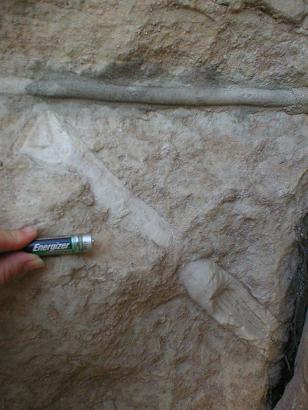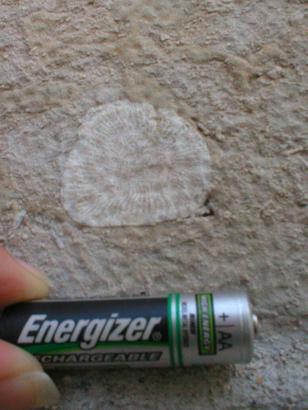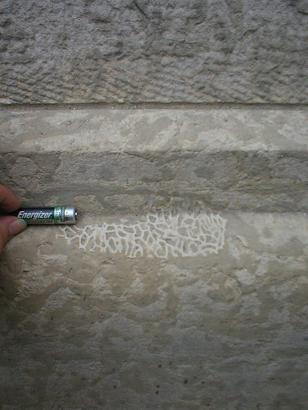| Current at 11/6/2011 (Online waypoint URL) |
|
You have already found this cache! Master Index Nearest Caches  Manitoba Tyndall Stone by junglehair (3/1)
Manitoba Tyndall Stone by junglehair (3/1)
N49° 53.303 W97° 08.079 (WGS84) UTM 14U E 633989 N 5527889 Use waypoint: GC12TPF Size:  Not chosen Hidden on 5/10/2007 Not chosen Hidden on 5/10/2007
In Manitoba, Canada Difficulty:  Terrain: Terrain: 




|
|
| This is an EarthCache located in Downtown Winnipeg. It is wheelchair accessible. All fossils can be found on the exterior of the buildings no more than 2 meters above ground. NOTE: The accuracy on your GPS will be low in these areas due to the obstruction of the buildings. Be prepared to search a wider area than usual. |
Tyndall Stone is used as an ornamental building stone in many cities in Canada and the United States. It is a light brown, fossil bearing limestone that has darker coloured branching streaks called trace fossils. While there are many limestones used as building stone in North America, Tyndall Stone is unique.
The colour, beauty and strength of Tyndall Stone has allowed for its use in a variety of ways and architectural styles. Impressive buildings containing Tyndall Stone include the Parliament Buildings in Ottawa, the Canadian Museum of Civilization in Gatineau, the Provincial Legislature in Manitoba, the Rimrock Hotel in Banff, and the Empress Hotel in Victoria.
Tyndall Stone is quarried at Garson, Manitoba, about 40 km northeast of Winnipeg. It was first discovered in the area around 1894, when a farmer came upon the mottled limestone while digging a well. The first large quarry was opened by William Garson in 1898. Gillis Quarries Limited began quarrying there in 1915, and the fourth generation of this family-owned business is still at it today.
How Did Tyndall Stone Form?
Four hundred and fifty million years ago, what is now southern
Manitoba was part of a warm, shallow, inland sea. During this time,
which geologists call the Ordovician Period, this area was just
south of the equator. Many different types of animals lived in this
ocean. Some, such as corals, sponges, molluscs, and algae, we would
recognize today. Others, such as trilobites and stromatoporoids,
are extinct. All of these creatures lived on or above the soft,
muddy sea floor. After they died, their remains became part of it.
The calcium carbonate in their skeletons made the mud limey, so
that when it hardened into rock it became limestone. Fossils of
these animals and plants are visible today in Tyndall Stone.
Other animals burrowed in the mud of the sea floor for food or protection. And it is the preserved burrows of these creatures that make the beautiful mottling which gives Tyndall Stone its unique appearance. Nobody knows what exactly these animals were, because the traces of their burrows are all that they left behind. But shrimp in the Caribbean Sea make similar burrows today, so it's possible these creatures were shrimp-like.
Why are the burrows a different colour from the rest of the rock? Well, it all comes down to a difference in grain size and chemistry. As the animals burrowed through the soft, limey mud, they left traces of their passage that caused the mud in the tunnels to be slightly different from the surrounding sediment. The more tightly packed surrounding mud hardened before the less dense deposits in the burrows. Later, magnesium-rich waters percolated through the rock and deposited dolomite in the burrows, but couldn't penetrate the tightly cemented limestone rock. The darker colour of the burrows may be a result of oxidation of trace amounts of iron in the dolomite, or of pyrite that was deposited along with the dolomite.
The information listed above was copied from a publication by the PDAC.
Requirements
To log this EarthCache, you must match the fossil name, with the correct photo and the coordinates where that fossil was found.
Fossils Names:
Colonial Coral: Calapoecia
Receptaculitid: Fisherites (often cited as Green Algae)
Horn Coral
Gastropod
Cephalopod
Chain Coral
Coordinates:
N49° 53.318 W097° 08.708
N49° 53.366 W097° 07.342
N49° 53.180 W097° 08.209
N49° 53.370 W097° 08.086
N49° 53.349 W097° 07.345
N49° 53.302 W097° 08.008
Photos:
Note: You can click on the photos to view a larger version.
Photo A |
Photo B |
 |
 |
Photo C |
Photo D Alternate image |
 |
 |
Photo E |
Photo F |
 |
 |
Complete the rest of this table, then email your answers to me using the profile link above.
| Photo | Name | Coordinates |
| Photo A | Colonial Coral: Calapoecia | N49° 53.318 W097° 08.708 |
| Photo B | ||
| Photo C | ||
| Photo D | ||
| Photo E | ||
| Photo F |
Special thanks to Jacques Bourgeois and Dr. Graham Young for their assistance in identifying some of the fossils. If I have made any errors, you can be certain they are my own.
 |
This cache was created to add to the number of QUALITY caches hidden in Manitoba. It is an official cache in the MBGA Cache Splash event. |
| Category 34: Earth Cache. |
| junglehair has earned GSA's highest level: |
 |
 .
. .
.
 . So it was a very interesting and busy day biking downtown. I've got to make a mental note to do it more often.
. So it was a very interesting and busy day biking downtown. I've got to make a mental note to do it more often. .
. Thats my story...and I'm sticking to it! - SPLASH! (0.23 kms E)
Thats my story...and I'm sticking to it! - SPLASH! (0.23 kms E)